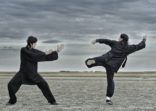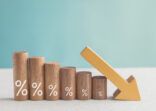

1. During this lock-in period, how often do you get outside and what do you do?
I’m currently back in my home town of Burnie, Tasmania with my family and my in-laws. Tasmania has been extremely pro-active in its actions to combat the spread of Covid-19. That means I don’t go out of our yard except to get groceries once a week and to exercise. Luckily we have a bit of a backyard, so we’ve been able to escape the worst of cabin-fever.
My daily routine hasn’t changed too much. As I do every day, I check the markets early in the morning, read a couple of newspapers, review our quant models, and then work on asset and manager research, and managerial tasks. In the current environment, we have been even more active in client communications, so it has been common for afternoons to be focused on clients. The major change has been looking after the children. My eldest son is in kindergarten, which has been closed. So I need to intersperse blocks of half-an-hour throughout the day helping him with reading, writing and numbers. And of course, some time for playing.
The biggest difficulty is the simple information sharing that takes place in an office. We can try to do that using other forms of communication, but it isn’t the same.
2. How are you communicating with clients and colleagues?
Oreana operates across Australia, Hong Kong and throughout Asia, so we’ve been using Zoom for some time now. But that has really increased over the past couple of months. We look for innovative ways to reach clients, since we can’t easily see them face-to-face. Recently, we ran a Zoom-based wine tasting. We partnered with Wine Brothers in Hong Kong who delivered wine to our clients, and then the wine maker from Auld Family Wines held a wine tasting after I gave an economic overview. It went really well – the engagement was probably stronger than face-to-face. So far, our clients have really embraced digital communication.
3. During the extreme market volatility and uncertainty about the shape of the economic recovery, what are some recurring client concerns?
Most of our clients were defensively positioned heading into this, as we had expected a recession in 2020. That means clients were prepared for volatility. But we have tried to be very proactive in sharing views, what we are doing in the portfolios, and where the risks lie to the outlook. We have also been able to focus on strategic advice, which is really critical in these difficult times, particularly for clients that face heightened uncertainty around jobs and whether they will remain in Hong Kong.
4. Compare the full year 2020 forecast for client portfolio performance today with the assessment in December 2019.
It is in line. Our portfolios were positioned for a global recession in 2020. Our goal now is to continue to maintain resilient portfolios that protect on the downside but access the upside when it comes.
5. How do you keep balanced and healthy during this period of isolation?
It is probably easier to maintain a work-family balance in this period. Working from home means more time spent with the family, particularly with my two young sons. It does means significantly longer hours though – having an office at home means I don’t really switch off in the evening. I do try to make sure to get outside for a short run every day to break up the scenery and recharge away from the desk.


1. During the market volatility and uncertainty about recovery timing, what specifically are recurring client concerns?
The recurring concern from partners at private banks and their clients has been what’s going on with portfolio liquidity in general.
Liquidity was top of mind for clients when we first saw credit markets come down in sovereign bonds and best-in-brand [bonds]. In Asia as you know a substantial amount of assets are in fixed income. Thankfully central banks have stepped in and put a backstop behind them. Every central bank is doing something to provide liquidity to these markets and that has helped calm nerves.
Also, after that significant first market drawdown, markets recouped somewhat. But liquidity is still a concern with clients. No one has a true sense of where markets are going and the news flow is rapidly changing day to day.
Internally, we’ve created a coronavirus internet site and are updating it on a daily basis. All our teams tell what’s going on with their portfolios and their expectations from a macro point of view. It’s important to stay out in front of the situation — private banks want their partners to be proactive during volatility. We use [the internal internet] for daily contact with partners to make sure they know were on top of the situation and we’ve also been using social media [for updates].
2. During the work from home period, how have you arranged to address client inquiries and how often?
No one has requested face to face meetings. In Singapore, the [partial shutdown of businesses] has been extended [to June]. We’ve been calling clients and using videoconferencing for portfolio management updates from our PMs or product specialists. We’ve had no issues in terms of technology. A couple glitches with Skype but those are minor.
3. What tasks can you do in the office that you cannot do well at home?
If there was no coronavirus [shutdown], I’d be meeting with clients face-to-face. But even now I do go into the office once a week. I suppose if we had to print out marketing decks then the office would be better, but there’s no need for that now and our offices in Singapore and most of Hong Kong are working from home. Other than that, it is business as usual. We report in every day from home.
4. How often do you get outside and what do you do?
I used to be an exercise guy – I did my share of working out 10 years ago. Working from home, I found it is quite easy to nibble all day and I found myself constantly raiding the refrigerator. The good thing is I’m an early riser, up at 5:30 or 6am to walk my beagle, who also wakes me up. Over the past two weeks I’ve been trying to go outside to run or at least walk some kilometers each day. At that time of day, there are plenty of ways to practice social distancing.

















